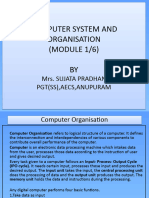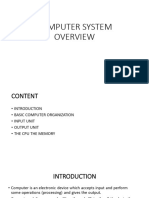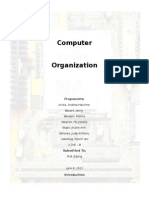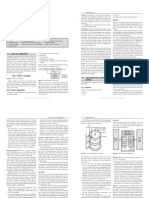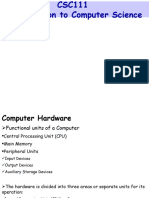0 ratings 0% found this document useful (0 votes) 8 views 23 pages Computer System Overview
A computer is an electronic device that processes input data and produces output results, combining hardware and software components. The basic organization of a computer includes input units, a central processing unit (CPU), memory, and output units, all interconnected via a system bus. Additionally, mobile systems function similarly to computers but are optimized for portability and specific applications, utilizing RAM and ROM for memory and various subsystems for processing and display.
Copyright
© © All Rights Reserved
We take content rights seriously. If you suspect this is your content,
claim it here .
Available Formats
Download as PDF or read online on Scribd
Go to previous items Go to next items
Save Computer System Overview For Later What is a computer?
A computer is an electronic device that can be programmed to accpect
input data, process the data according to the user's need and export the
result that would be output.
* Acomputer system combines hardware and software to process
data, converting input into meaningful form
«Hardware: The physical electronic components of a computer are
called hardware, Example: Keyboard, CPU, monitor, printer etc
© Software: These are the recorded instructions and programs that
govern the working of a computer.
Basic computer Organization
Computer organization refers to the logical structure of a computer
describing how its components are connected: how they effect one
another's functioning and contribute to the overall performance of the
computer.
Computers follow the ‘IPO’ principle i.e., Input > Process — Output.
So, the computer organization is also like this these are component (s)
dedicated to obtaining input in diferent forms, component(s)dedicated to
performing processing parts and component(s) to produce output in
different forms.�Input Unit
Since a computer operates on electricity, it can understand only the
language of electricity i.e., either ON or OFF or high voltage or low voltage.
That means a computer can understand two stages ON/OFF or High/Low
voltage or the binary language that uses just two symbols: 1 for ON and 0
for OFF,
The input unit is responsible for taking input and converting it into
computer-understandable form (the binary code).
Computer input also consists of data and instructions,
Example ~ If we give the computer to add 5 + 5, then;
© Data: itis 5 and 5
¢ Instruction: Addition
Example — If we give the computer input as print “Hello World”
© Data: “Hello World”
¢ Instruction: Print�The input unit is consist of different input devices that take the input in
different forms and pass them in digital form to CPU for processing
‘Some common input devices are
1. Keyboard: A keyboard is a typewriter-like device that is used to type in
letters, digits and commands
2. Mouse: The mouse is a pointing device with either a roller on its base
or some laser mechanism. Mouse controls the movement of pointer
(also called the mouse pointer) on the screen.
3. Microphone(Mic): We can send sound input to a computer through a
special input device called a microphone or mic in short. A mic
converts the sound received into a computer's format, which is called
digitized sound or digital audio. A mic can work if your computer has
a special hardware known as a sound card,
Output Unit
The output unit is responsible for converting binary signals into
human-readable form, i.e., characters, graphical or audio-visual form.
Some common output devices are:
1. Monitor: It displays information. The pictures on a monitor are made
up of thousands of pixels.�2. Printers: Printers are the devices that deliver information using
printed characters on paper.
3. Speakers: Speakers receive sound in the form of electric current from
the sound card and convert it into an audible format for users.
CPU Unit - Central Processing Unit
The CPU is the main control center where processing takes place. it is often
called the brain of the computer.
The CPU is parted into 3 parts that is:
1. ALU: Arithmetic Logic Unit
2. CU: Control Unit
3. Registers
ALU - Arithmetic Logic Unit
ALU can perform all four arithmatic (+, -, /, *) and Logical (>, <, =,
Arithmetic
© When two numbers are added, these are sent to the ALU from the
memory.
* The addition takes place then the result is put back in the memory.
Logical�Sent to the memory to ALU where the comparison takes place
© And returned to memory
CU - Control Unit
The CU sends control signals until required operations are done by ALU and
memory. The CU controls and guides the interpretation, flow and
manipulation of all data and information.
CU acts as a supervisor by controlling and guiding the operation taking
place
* CUacts as a supervisor by controlling and guiding the operation
taking place
© Another important function of CU is the program execution i.e.,
carrying out all the instructions stored in the program. The CU gets
program instructions from memory and executes them one after the
other. After getting the instructions from memory in CU, the
instruction is decoded and interpreted i.e., which operation is to be
performed.
© Then the asked operation is carried out. After the work of this
instruction is completed, control unit sends signal to memory to send
the next instruction in sequence to CU.
© The control unit even controls the flow of data from input devices to
memory and from memory to output devices.�Registers
© Registers or processor registers are small units of data holding
places
© The CPU uses registers to temporarily hold some important
processing information during the time the processing is taking
place.
© CPU may store some part data or some memory address or some
instruction in its processor registers.
Memory (Main/Primary)
The memory of a computer is more like a predefined working place, where it
temporarily keeps information. Each memory location has a unique
memory address.
When the task is performed, it clears its memory and memory space is then
available for the next task to be performed.
When the power is switched off, everything stored in the memory gets
erased and cannot be recalled
«The memory of a computer can be thought of as ‘cells’. Each of these
cells is further broken down into smaller parts known as bits.
® Abit means a binary digit ie., either 0 or 1. Several bits together are
used to store data instructions by their combination.�© Abit is an elementary unit of memory. Eight bits together form a byte.
© One byte is the smallest unit which can represent a data item or a
character.
© Other units of memory are KB, MB, GB, TB
© Every higher memory unit is equal to 2 of its lower unit
‘Some most common secondary storage media are hard disk, CD-RW’s, pen
drives &b etc. The secondary memory devices are also known as storage
devices.
RAM - Random Access Memory
RAM allows information transfer from any random location, but its main
drawback is that it loses all data when power is lost due to its volatile
nature.
RAM in a computer can be of two types
1. Dynamic RAM (DRAM): These are made of transistors and
capacitors. Today's DRAM Chips have access times below 20-70
nanoseconds.�2. Static RAM (DRAM): These are made up of flipflops and offer faster
access times (about 10 nanoseconds) than DRAMS, thus are utilized
in specialized applications.
The amount of time taken to produce data required from memory, from the
start of the access unit the availability of data is called memory access
time.
ROM- Read Only Memory
¢ ARead-Only Memory (ROM) is a memory unit that performs the read
operation only; it does not have a write capability. This implies that
the binary information stored in a ROM is made permanent during the
hardware production of the unit and cannot be altered by writing
different words into it (hence non-volatile).
Whereas RAM is a general-purpose device whose contents can be
altered during the computational process, a ROM is restricted to
reading words that are permanently stored within the unit.
* ROMs are used for applications in which it is known that the
information never needs to be altered. Example: a monitor program
controlling a machine. These, however, are slower than RAM
There are many types of ROM, but we will only cover that's in our syllabus:
1. PROM (Programmable ROM): Also called OTP (One Time
Programmable). PROM is a user-programmable memory in which
information is burnt using special equipment called a ROM burner.
2. EPROM (Erasable Programmable ROM): In EPROM, one can program
the memory chip (through various mechanisms e.g., UV radiation)�and erase it many times as needed. The UV-EPROM can take up to 20
minutes to erase EPROM contents.
3. EEPROM (Electrically Erasable Programmable ROM): In EEPROM, the
EPROM is erased electrically which is faster. Also, with EEPROM,
selective bytes can be erased, unlike UV-EPROM which erases fully.
4. Flash EEPROM: It is like EEPROM but is very fast comparatively (the
erasure of the entire contents takes less than a second). Also, it
erases fully and not selectively.
Mask ROM: Mask ROM is a kind of ROM in which the IC manufacturer
a
programs the contents. It is not a user-programmable ROM.
Storage Unit
Since primary memory has a limited storage capacity and is not permanent,
secondary storage devices are used to store large amount of data
permanently.
There are various types of secondary devices available these days. To
specify the storage capacity of storage devices, same units of memory are
used, which are used for measuring primary memory. That is, we can
represent the storage capacity of storage devices in terms of kilo bytes
(KB's), mega bytes (MB's), giga bytes (GB's) and tera bytes (TB’s) as we do
for main memory.
Some common storage units are:�1. Hard Disks: The hard disk memories store information on one or
more circular platters (or disks) which are continually spinning.
©. These rotating disks are coated with a magnetic material and
stacked with space between them. Information is recorded on
the surface of rotating disks by magnetic heads as tiny
magnetic spots. The hard disks of today have storage capacity
measured in giga bytes upto tera bytes.
Compact Disks: (CDs) The compact disks or CDs are optical media.
The CDs are relatively cheap and have a storage capacity of upto 700
Mb. There are three main types of CDs:
© (i) CD-ROM (Compact Disk-Read Only Memory): This is used
only to store information and cannot be used to store data. It is
mainly used for CD distribution e.g., encyclopedias, software,
games, e-books etc.
© (ii) CD-R (Compact Disk Recordable): It is mainly used for CD-R
and can be written on only once and disk can't be erased.
© (iii) CD-RW (Compact Disk-Rewritable): CD-RW is an erasable
disk you can write on multiple times.
DVDs: DVD is an optical storage device that looks the same as a
compact disc but is able to hold about 15 times as much information
and transfer it to the computer about 20 times as fast as a CD-ROM.
A DVD, also called a Super Density disk (SD), can hold upto 17
gigabytes of data or four hours of movies on a side. DVDs also come
in three varieties.
© (i) DVD-ROM: This is read only DVDs i.e., once recorded initially,
you cannot write on it.�© (i) DVD-R (DVD-Recordable): DVD-R similar to CD-R’s allow
users to write on the disc once but read it many times.
(iii) DVD-RW (DVD-Rewritable): Most writable DVD drives are
DVD-RW You can erase and read many times on them
4, Flash Memory: A flash drive is a small, ultra-portable storage device
with a ‘solid state’ memory i.e., it has no moving parts unlike
magnetic storage devices, nor does it make use of lasers — unlike
optical drives.
°
Instead, it works in a similar way to RAM. The key difference is
that data is retained in Flash memory even when the power is.
switched off. They are now fairly inexpensive, costing from
250/- upwards. Typical sizes range from 256 Mbytes up to 128
GB and beyond.
. Blu-Ray:Disk Blu-ray Disc (also known as Blu-ray or BD) is an optical
disc storage media format. Its main uses are high-definition video
and data storage.
The disc has the same dimensions as a standard DVD or CD.
The benefit of using a blue-violet laser (405 nm) is that it has a
shorter wavelength than a red laser (650 nm), which makes it
possible to focus the laser spot with even greater precision.
This allows data to be packed more tightly and stored in less.
space, so it's possible to fit more data on the disc even though
it's the same size as a CD/DVD. Blu-Ray disks of today are
capable of storing upto 128 GB of data.�While current optical disc technologies such as DVD, DVD+R, DVD+RW, and
DVD-RAM rely on a red laser to read and write data, the new format uses a
blue-violet laser instead, hence the name Blu-ray.
System Bus
The system bus (or the bus) is an electronic pathway composed of
connecting cables and that connects the major components of a computer
system. Through system bus, data and instructions are passed among the
computer system components.
© The data carrying part of system bus is called data bus.
* The control instruction carrying part of system bus is called control
bus.
© The memory address carrying part is called address bus.
* A separate type of bus called I/O Bus connects the Input, Output and
other external devices to the system.
Mobile System Organization
Modern mobiles are tiny computers in your hand. Although they have less
computing power compared to their bigger versions, they handle diverse
type of applications such as making calls through radio signals, offering
camera utilities, handling touch sensitive screen, display
audio/video/graphical content but having little battery based power etc.�Mobile Processor
This is the brain of a smartphone. The CPU receives commands, makes
instant calculations plays audio/video, stores information and sends
signals throughout the device.
The CPU of a mobile system has majorly two sub-processor types
Processing Unit.
1
Communications Processing Unit : This subsystem is responsible for
making and receiving phone calls on a mobile handset. it has a digital
signal processor that helps it work with RF Transceiver and the Audio
subsystem.
© Radio Signal Management Unit is responsible for connecting
SIM (which provides a type of modem) to the base stations
through radio signals (3G/LTENG based cellular networks).
. Applications Processing Unit (APU). This subsystem is responsible
for governing controlling all types of operations taking place on a
mobile system by running various types of mobile applications
(apps).�Display Subsystem
This system is responsible for providing display facilities, touch sensitive
interface and touch sensitive keyboards.
Camera Subsystem
This subunit is designed to deliver a tightly bound image processing
package and enable a improved overall picture and video experience.
It has an integrated Image Signal Processor ensures things like instant
image capture, high-resolution support image station, and other image
enhancements
Mobile System memory
A mobile system memory is compromised of two memories:
1. RAM (Random Access Memory): It is the work memory of your
mobile system.�© The installed mobile apps, when run, are first loaded in the
RAM and then executed. These apps remain in the RAM after
you are no longer using them and then they are shifted to
background.
2. ROM (Read Only memory): The ROM or Read Only Memory is a part
of mobile system's internal storage and it is not accessible for users
to write on and is thus referred to as Read Only Memory.
© The ROM is basically Flash memory or technically EEPROM
(electrically erasable and programmable read-only memory)
RAM is a volatile memory, hence it loses its memory when you switch off
the device
This subunit is designed to deliver a tightly bound image processing
package and enable a improved overall picture and video experience. It has
an integrated Image Signal Processor ensures things like instant image
capture, high-resolution support image station, and other image
enhancements
Storage
The external storage of a mobile system is also called expandable storage.
It comes in the form of SD cards, or micro SD cards etc. It is the storage
which can be removed easily by you and can be used for storing pictures,
music, videos and the likes.�To an extent, even the cloud storage can also be categorized as external
storage.
Battery - Power Management
System Software
Instructions are provided to the computer through software. The software
that controls internal computer operations (viz. reading data from input
devices, transmitting processed information to the output devices, checking
system components, converting data/instructions to computer
understandable form etc.) is known as system software. The system
software can further be classified into two categories:
1. Operating System
2. Language Processor
Operating System
The primary goal of an OS is to make the computer system convenient to
use & Secondary goal is to use computer hardware efficiently.�An operating system is an important component of a computer system
which controls all other components of the computer system.
Major components of a computer system are:
1. The Hardware
2. The Operating Software
3. The application program routines (compiler, linkers, database
management systems, utility programs)
4, The Humanware (Users)
‘An Operating System is a program that acts as an interface between a user
and the hardware (i.e., all computer resources).
© Application program routine: the ways in which these resources are
used to solve the computing problems of the users.
* The OS controls and coordinates the use of the hardware among the
various application programs for various users.
© There are different types of operating systems available today to
cater to varied type of requirements. Example: Single user OS,
Multiuser OS, Time sharing OS, Real time OS, Multiprocessing OS,
Distributed OS ete.�Language Processors
A special type of computer software that can translate the source code into
an object code or machine code.
Source Code
1. Source code: refers to the program-code written by a programmer in
a High Level programming Language (HLL) such as in C, Java, C+
etc.
2. Object code: refers to a code usually in machine language or binary
code, a language that computer can understand easily and run on
hardware.
There are three types of language processors:
1. Assembler : This language processor converts the program written in
assembly language into machine language.
2. Interpreter : An interpreter is a type of system software that
translates and executes instructions written in a computer program
line-by-line, unit by unit etc.
3. Compiler : A Compiler is another type of system software that
translates and executes computer program in one go.�Application Software
This type of software pertains to one specific application
example: a software that can perform railway reservation functions cannot,
prepare result for a school.
These are the programs written by programmers to enable computer to
perform a specific task such as processing words, inventory control,
handling calculations and figures, medical accounting, financial accounting,
result preparation, railway reservation, billing etc.
Application software can further be subdivided into four categories
1. Packages
Utilities
Customised Software
RON
Developer Tools
Packages
‘Some general software designed that may be used by individual users in a
manner that suits their needs and requirements are called Packages.
As applications may be numerous (from thousands to millions of them), it
is not feasible to design software for each one of them. Rather some
general software are designed that may be used by individual users in the�manner it suits their needs and requirements. Such general-application
software are known as packages. Some major and most common
categories of general application software (packages) are:
* Word Processing Software
© Spreadsheets
© Desktop Publishing Software
© Graphics, multimedia & presentation applications.
© Database Management Systems
Utilities
Utilities are those application programs that assist the computer by
performing housekeeping functions like backing up disk or scanning /
viruses or arranging cleaning information etc.
These are those useful software that ensure smooth functioning of the
computer.
Some of the important utilities are mentioned below
1. Text editor: Creating, and editing text files.
2. Backup Utilities: Utility program facilitates the backing-up of disk.
Back-up means duplicating the disk information so that in case of
any damage or data-less, thus backed up data may be used.�3. Compression Util
This utility program facilitates compression of
files. Large files can be compressed so that they take less storage
area
4. Disk Defragmenter: A file is fragmented when it consumes to large
for your computer to store in a single location on a disk.
© When this happens, your computer splits the file up and stores
it in piece. You can use fragmented files, but it takes your
computer larger to access them
© Disk Defragmenter utility program speeds up disk access by
rearranging the files and Free space on your computer
5. Antivirus Software: This utility program ensures virus-free work
environment.
°
°
A computer virus is a malicious computer program that
disrupts normal functioning of a computer.
An antivirus software scans your disk for viruses and removes
them, if any virus is found.
Moreover, some antivirus software remains present in memory
all the time so that they can detect the viruses (as soon as they
occur) and counterattack them�Business Software
This type of software is specifically created software according to a
business requirements. This type of software is developed to meet the
general requirements of a business.
There are many readymade business software that can cater to a variety of
business needs.
However, such software cannot be directly installed at any other
user's workplace as the requirements of the second user may differ
from the first and the software may not fit in the requirements of the
new user.
Software Libraries
A software library is a predefined and available to use, suite of data &
programming code in the form of prewritten
code/functions/scripts/classes etc. that can be used in the development of
new software programs and applications.
When programmers develop software and programs, they have a prewritten
set of code/functions, classes, scripts etc available to do a variety of tasks,
which they can use directly in their code. These predefined sets of codes
are called software libraries.�The software libraries combine codes/ functions/scripts/classes etc., on
the basis of their common domain. In order to use the rewritten
functionality, a programmer needs to add that libraries to its code.
1. NumPy :It provides an abundance of useful features and functions
for operations on numeric arrays and matrices in Python.
2. SciPy : Contains modules for Linear algebra, optimization, integration
and statistics.
3. Panda: Itis a python framework to handle “labelled” and “relational ”
data.


